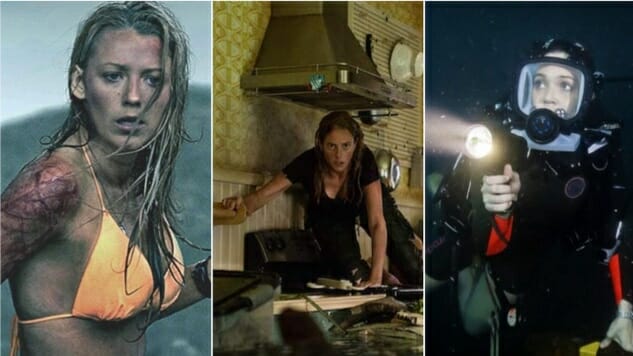The Shallows, 47 Meters Down, Crawl and the Surfacing of a Sub-Genre

A thriller that take place entirely in a single location, focusing on a single character’s fight for survival, is hardly a new premise—it’s been especially popular during the last two decades. Prominent examples range between intensely claustrophobic exercises in suspense like Buried, which takes place entirely inside a coffin, to more dramatic and character-oriented affairs like Danny Boyle’s 127 Hours, about a hiker coming to terms with breaking up with his own arm. The allure of these productions is both practical and artistic. On the practical side, they can be executed with minimal budgets and casts, the high-concept premises alone enough to make their money back many times over. Artistically, it gives filmmakers an excuse to stretch the limits of their craft to see how much they can draw out the tension while sticking to a single location. Not to be overlooked, they also provide an actor the chance to be the center of attention from first frame to last.
Recently, a new offshoot of the sub-genre has emerged—one with such specific parameters that it’s practically turning into a sub-genre of its own: young women struggling to survive giant predatory animals within a single location. Aside from their countless low-budget straight-to-VOD rip-offs, there are three clear examples that come to mind: 2016’s The Shallows, 2017’s 47 Meters Down, and the recently released Crawl. The sharp-toothed antagonists in The Shallows and 47 Meters Down are sharks, while Crawl spices things up by switching to giant Florida gators. During a time when we’re increasingly aware of stories of women feeling trapped inside their workplaces, neighborhoods and even homes by unwanted, dangerous attention, it’s worth noting the surge in popularity of thrillers about literal predators obsessed with devouring their female prey.
All of the writers and directors of these movies are men, yet they surprisingly contain little of the male gaze and the exploitation-adjacent perspective that gives the audience thrills from the point-of-view of the hunter. From the first moment to the last, we identify with the female victims and root for their survival. These protagonist are capable and resourceful, mostly making smart and focused decisions. This is practically a requirement of the sub-genre. If it’s an ensemble cast made up of a bunch of characters who are to be picked off one by one, it’s okay to include a couple of idiots to throw the audience some fun and easy kills. But when you’re dealing with one character almost for the whole movie, a single unwise decision for the purpose of plot convenience can turn the audience against the protagonist and ruin the credibility of the entire enterprise.
Even though none of these three flicks are connected to each other in any official fashion, it’s certainly fascinating how closely they follow the exact same story structure. The first act is spent entirely on setting up the backstory of the protagonist, with almost no stylistic indication that we’re about to watch a single-location survival horror. In fact, if one doesn’t know anything about the films themselves, one could easily think these are dramas about young women overcoming their inner conflicts. Of course these conflicts are introduced as a way to infuse some sort of a character arc for the protagonists, since a feature focused only on the episodic machinations of survival will eventually feel like not much more than a glorified theme park ride. The funny thing of course is how these inner conflicts just happen to be related to the eventual inner strength the characters will need in the third act in order to survive.
-

-

-

-

-

-

-

-

-

-

-

-

-

-

-

-

-

-

-

-

-

-

-

-

-

-

-

-

-

-

-

-

-

-

-

-

-

-

-

-








































